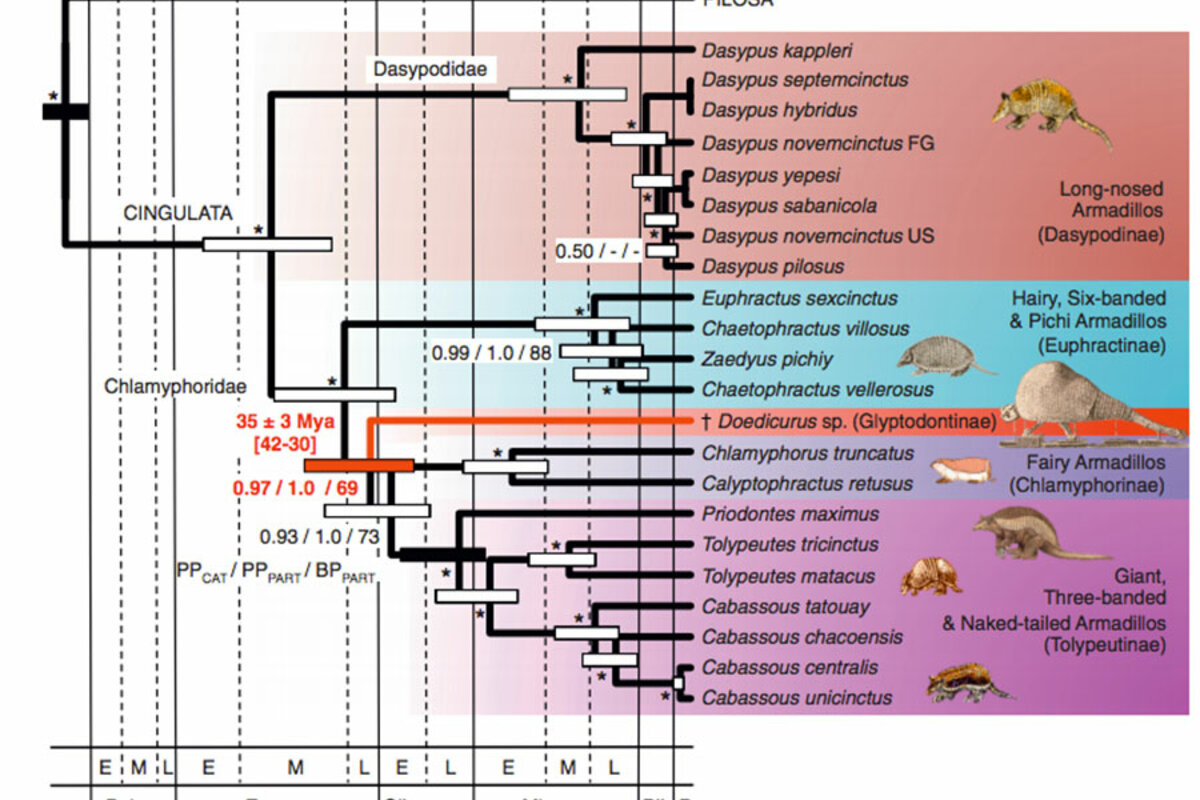What is that huge-armadillo-looking thing? A huge armadillo, say scientists.
Loading...
Glyptodonts, humongous armored prehistoric beasts, looked like armadillos. Despite size differences, both animals have similar body shapes and bony skin that forms a shell over their backs, tails, and heads.
But scientists have long debated the extinct Volkswagen Beetle-sized animal's place in the family tree. Some suggested glyptodonts are armadillos. Others posited that the gigantic animals' lineage split off and they are cousins to today's armadillos. Some scientists even suggested that glyptodonts were more distant members of the superorder Xenarthra, which includes armadillos, anteaters and tree sloths.
But a new study places glyptodonts firmly within the armadillo family.
In an effort to determine glyptodonts' relationship to extant armadillos once and for all, geneticists dug into the ancient animals' DNA. The team sequenced the mitochondrial DNA of a 12,000-year-old fossil belonging to the genus Doedicurus, the largest and most recent of the glyptodonts. Their results revealed the immense animals are indeed buried deep in the armadillo family, according to a paper published Monday in the journal Current Biology.
It's not all that surprising to find that glyptodonts are in fact armadillos, Darin Croft, a paleomammalogist at Case Western Reserve University who was not part of the study, tells The Christian Science Monitor. But it is intriguing that they are so deeply embedded in the group, he says.
In fact, the DNA analysis suggests that the car-sized armored mammals are most closely related to both the smallest and largest living armadillos.
"Glyptodonts are the sister taxa to the pink fairy armadillo. If you look at the shapes and sizes of these two creatures, no one would have guessed that," evolutionary geneticist Hendrik Poinar, a senior author on the paper, tells the Monitor.
Ranging from the size of a large bear to the size of a small car, glyptodonts would have dwarfed pink fairy armadillos, which, at up to 5 inches inches long, could fit in the palm of your hand.
The new research suggests that Glyptodonts are also closely related to another group of armadillos, Tolypeutinae, a subfamily that includes Giant, Three-banded, and Naked-tailed armadillos. Giant armadillos are the largest living species of armadillo, with an adult length of up to 59 inches (including its 20 inch tail).
Doedicurus, Tolypeutinae and Chlamyphorinae (fairy armadillos), diverged from a common ancestor around 35 million years ago, according to the DNA analysis.
"It just shows the remarkable expansion and contraction that goes on through the evolutionary history of this species," Dr. Poinar says of the glyptodonts' size.
The gigantic armadillos were much larger than their medium-sized ancestors, he explains. And the much smaller animals are the ones still alive. "I think its position in that size variation just shows the remarkable plasticity of evolution," Poinar says.
So how could one group of animals evolve such dramatically different sizes?
A number of factors could explain the animals' varying sizes. The fairy armadillo is highly adapted for digging, with wedge-shaped bodies, says Dr. Croft. For a burrowing animal, it would have made sense to have a small body.
Glyptodonts' humongous size may have come from a need to be more protected from predators, as a larger mammal is harder to take down. Or perhaps it had something to do with the animal's eating habits, Croft says. While other armadillos were insect eaters, glyptodonts ate plants. Croft says scientists have spotted a link between plant eaters and body size before.
Poinar suggests that the animals' distinctive shells might have led to their impressive size. Modern-day armadillos' shells are made up of separate plates of armor, but glyptodonts had fused shells. That would have made it difficult to move around, and size could have helped.
Glyptodonts went extinct along with the mammoth, mastodon, saber-toothed cats, and other megafauna living across the Americas around 11,000 years ago. Scientists have long thought humans played some role, whether direct by hunting them or indirect by changing the habitat, in this extinction event.
Glyptodonts lived across the Americas through the Pleistocene, when humans began trekking into the region from Eurasia over the land bridge. So it makes sense that people would have seen and possibly interacted with the humongous animals.
With a long, spiky clubbed tail and covered in armor, the hefty Doedicurus would have cut an imposing figure. The animal's tail may have been used both for protection from predators and for battles among individuals, much like deer use their antlers.
Hunting the humongous armadillo would have been a daunting task (modern-day armadillo armor can stop a bullet), but, as Croft says, "Hunger can be a pretty strong motivating factor."







